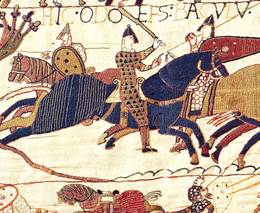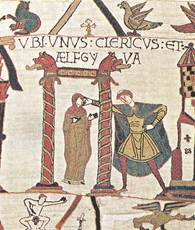|
Sarah Bower | A Story Hidden in the Tapestry
March 16, 2012

Thanks for inviting me on to your blog to talk about my new novel, THE NEEDLE IN THE BLOOD.
The novel is a love story set against the backdrop of the Bayeux Tapestry which
– for readers who aren't familiar with it – is a strip of
embroidered linen over 230 feet long which tells the story of the Norman
invasion of Britain in 1066. Its survival for nearly a thousand years is little
short of miraculous (and it has had some hair-raising adventures during the
various wars that have been fought in Northern France over the centuries, not
least at the hands of the Nazis!), and what it tells us about military and
social life in the eleventh century is invaluable. Despite all this, in England, we take it very much for granted. 1066 is the one
historical date everybody knows, and the Tapestry's images are almost the
wallpaper to our history. They crop up everywhere, from mugs to mouse mats, and
have been lampooned in all kinds of ways from political cartoons to one image I
found recently of Batman stitched into the narrative! (You can see this on THE NEEDLE IN THE BLOOD's
Facebook page.) What made me begin to see it differently, to really look at it for the first
time, was this image: 
Here we see a woman and child fleeing a burning house, and this is possibly the
earliest image in Western art of what war does to civilians. It shows that the
Tapestry's narrative is more nuanced than it first seems, that it isn't just
Norman propaganda but a story about real people. Once I began my research, the historical figure who emerged most strongly for me
was Odo, the Bishop of Bayeux and half brother of William the Conqueror, who is
widely supposed to have been the Tapestry's patron, though this isn't known for
sure. 
The chronicler Orderic Vitalis says of Odo that ‘in this man...vices were
mingled with virtues, but he was more given to worldly affairs than to spiritual
contemplation'. Although very little has been written about Odo in modern
scholarship, this contradictory, almost split, personality comes out in all the
literature, and in the evidence of his life. As Bishop of Bayeux, Odo was
esteemed for endowing a new cathedral, a school and library, and new housing for
his clerical staff. A Mass was said in Bayeux Cathedral every year on the
anniversary of his death (6th January 1097) right up until the French
Revolution. In England, by contrast, where he served as Regent for William and was made Earl
of Kent, as well as holding some 400 other manors in the south of England (Odo
was one of several Normans to appear in The Times all-time rich list,
compiled in 2007, with a fortune worth, in today's money, £55.5 billion), he had
a reputation for avarice, brutality and, according to Orderic, ‘frivolity' (as
possibly borne out by the sort of harlequin suit he appears to be wearing over
his armour in the picture!). I found myself intrigued by this apparent change of
personality after the Conquest and what might have brought it about. We tend to
focus on the trauma suffered by those who are the victims of invasion, but what
about the invaders themselves? The risks William took, political, economic and
physical, in invading England were astronomical. There was, quite literally for
many of his followers, no going back. The social order established by the Normans was an extraordinary achievement.
Its material monuments, the castles and cathedrals, still define our landscape.
The Normans introduced trial by jury, rabbits and peas, among other things which
have persisted to the present day. We know how dearly this process cost the
Anglo Saxons, but what price did the Normans themselves pay? It seemed to me
that the brutalisation of Odo could be used as a metaphor for exploring that
question, and that, somewhere in the Bayeux Tapestry, commissioned by him but
made in England by English embroiderers, I might find answers. What, or who, I found was the mysterious Aelfgyva. 
I don't want to spoil the story for you, so will say no more, but if you look at
this image, and all the other little pictures around it, hopefully you will want
to read more about Odo, the priest, and his mistress. Want to win your own copy of THE NEEDLE IN THE BLOOD?
Leave a comment below about what you think about the tapestry or hidden messages
in art.
Comments
23 comments posted.
Re: Sarah Bower | A Story Hidden in the Tapestry
I love history and I love art. Your blog was very interesting because I had never heard of this tapestry. About hidden meanings in art, I am not so sure. We look at things differently today than people did long ago. If it was not documented at the time, it is hard to tell. But, it is fun to imagine and they sure make for a good story.
(Kathleen Yohanna 4:32am March 16, 2012)
It is fascinating. Imagine the thinking that went on in creating the tapestries.
(Mary Preston 5:36am March 16, 2012)
I love how the weaver of the tapestry could put in little things that gave clues to what went on in that time.
(Debbie Penny 6:48am March 16, 2012)
I think the concept of weaving hidden messages in tapestries is really interesting. I read another book called "Violet Eyes" that had a secret hidden in a tapestry about the Kingdoms Princess surviving an attack and I thought it was really interesting then.
(Chelsea Knestrick 7:06am March 16, 2012)
I've read a little bit about this tapestry before but I had no idea it was 230 feet long. Phew! That's a lot of stitching. The whole concept is just amazing!
(Karen Gervasi 7:25am March 16, 2012)
I think the idea of hidden messages in a tapestry is very intriging---puzzles are always so facinating.
(Sue Farrell 10:40am March 16, 2012)
It is fun to find the hidden messages in art. Frankly speaking my knowledge of the Bayeux Tapestry is very general. Am intrigued by your book.
(G. Bisbjerg 10:56am March 16, 2012)
Art holds its own meaning, there have been
symbols found especially during times of
persecution. It's amazing that when we see a
symbol what that means to us as an individual.
Thank you for sharing the tapestry.
(Carla Carlson 12:06pm March 16, 2012)
Thanks for the great post! I love reading about real
historical events and I love the premise! I can't imagine what
it would take to create a tapestry of that size and detail...
let alone while living the events.
(Erin Fender 12:17pm March 16, 2012)
The intricate designs in a tapestry are impressive, I have always admired those
who could take the time and effort to make something so detailed. And it is fun
to look at them and try figure out what the person was trying to portray, like in a
painting. One main idea that is obvious, but others can be hidden and make you
search for them.
(Lexi Hansen 5:34pm March 16, 2012)
sounds fascinating.
(Lori Belcher 5:40pm March 16, 2012)
The history of the tapestry is so interesting. I can't even imagine the women who had to work on it. They were amazing artists and storytellers.
(Jennifer Beyer 9:16pm March 16, 2012)
I don't have a Facebook account, so I won't be able to look at the tapestry further, which is a disappointment. I wish that I were able to see the tapestry in an enlarged form, because it has me intrigued. Things like this fascinate me for some reason. I enjoy studying items, and if I find something I didn't see before, it excites me. The tapestry would be like a treasure trove of information - such wealth at your fingertips!! Since I don't have the tapestry, I'll have to settle for what you've written as my only source of information. Thank you for keeping this bit of History alive.
(Peggy Roberson 9:26pm March 16, 2012)
I love tapestries. I have a wall sized one hanging in my bedroom. It has a garden and water fall.
(Molly Wilsbacher 10:25pm March 16, 2012)
Sounds like an interesting take on the concept of hidden messages in art. I look forward to reading it!
(Holly Sanders 10:26pm March 16, 2012)
I look forward to reading this book!
(Susan Ashcraft 11:30pm March 16, 2012)
I have never heard of this tapestry. The period surrounding 1066 has always
fascinated me. I can't even tell you why. We covered the Battle of Hastings very
thoroughly in school as if our teacher was as fascinated as I. This book is right
down my alley. Thank you. I will be looking for it.
(Sandra Spilecki 10:43am March 17, 2012)
Amazing what art can tell us of a certain period in history.
(Shirley Nienkark 4:43pm March 17, 2012)
I am fascinated at the images of the tapestry and detail as well as colorful. I'm sure there are hidden messages in the story they depict which hold symbolic meaning from the times they were produced and that's why they were created to tell the story through needlework. So beautiful and imagine the hours spent. I'm sure there are a few others such as this Bayeux Tapestry in museums, that have withstood their test of time. Thanks for sharing this amazing story and how it was incorporated into your book.
(Linda Luinstra 5:26pm March 17, 2012)
I viewed the Facebook Page and it's quite interesting how the "winged rodent" resembles "Batman" on the tapestry! Also liked the "History Undressed" portion (so colorful) with the knights with shields. I like artwork and appreciate things like this and find it very interesting. Thanks!
(Linda Luinstra 5:36pm March 17, 2012)
The history depicted in a tapestry in artful images definitely holds a few hidden messages. This book sounds like a great read.
(Rich Cook 5:47pm March 17, 2012)
My grandmother would spend hours working on hand made quilts. I know how careful she was with each hand stitch, so I can only image the time and patience it involved in making such a tapestry
(Rejeana Thompson 3:01pm March 18, 2012)
There's a Tapestry Museum in Washington D.C. that has many fabric pieces on display rich in history. I like reading the descriptions and coming up with a few of my own. There's a lot of symbols and traditions in tapestry which reflects the time is was made, the fabrics available and the functionality of the piece.
(Alyson Widen 7:53pm March 23, 2012)
Registered users may leave comments.
Log in or register now!
| 

 © 2003-2024 off-the-edge.net
all rights reserved Privacy Policy
© 2003-2024 off-the-edge.net
all rights reserved Privacy Policy